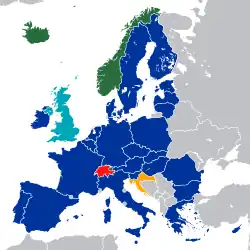European Economic Area
The European Economic Area (EEA) was established because of the Agreement on the European Economic Area, an international agreement which lets the extension of the European Union's single market to members of the European Free Trade Association.[5]
European Economic Area
| |
|---|---|
 EU states which form part of the EEA EFTA states which form part of the EEA EU state which forms part of the EEA through the provisional application of an accession agreement EFTA state which signed the EEA agreement but did not join
Former EU state which has withdrawn from the EEA | |
|
|
| Member states[2][3] | 26 EU member states 3 EFTA member states 1 EU member state the EEA agreement provisionally applies to |
| Establishment | |
• EEA Agreement signed | 2 May 1992 |
• Entry into force | 1 January 1994 |
| Area | |
• Total | 4,944,753 km2 (1,909,180 sq mi) |
| Population | |
• 2021 estimate | 453,000,000 |
| GDP (nominal) | 2020 estimate |
• Total | US$16.3 trillion[4] |
• Per capita | US$39,537 |
References
- "Láhkasánit - Saamelaiskäräjät" (PDF). Sámi Parliament of Finland. Retrieved 29 August 2019.
- "Agreement details". Council of the European Union. Retrieved 7 July 2013.
- "Agreement details". Council of the European Union. Retrieved 23 April 2014.
- "Report for Selected Countries and Subjects". www.imf.org.
- "The Basic Features of the EEA Agreement - European Free Trade Association". www.efta.int.
This article is issued from Wikipedia. The text is licensed under Creative Commons - Attribution - Sharealike. Additional terms may apply for the media files.